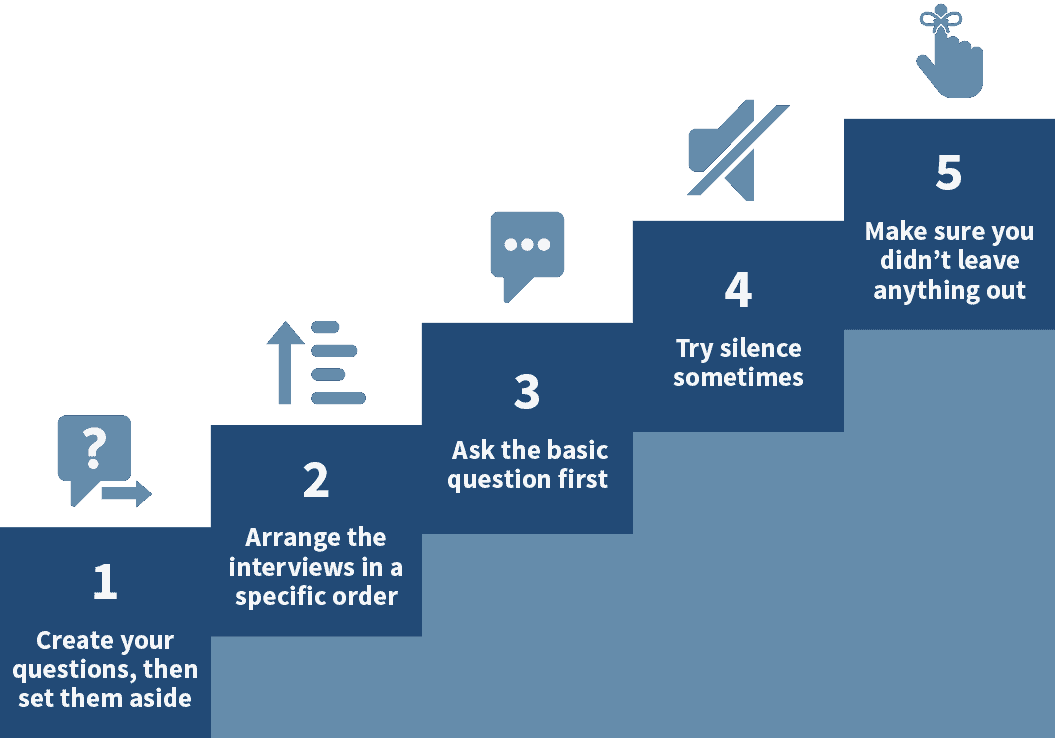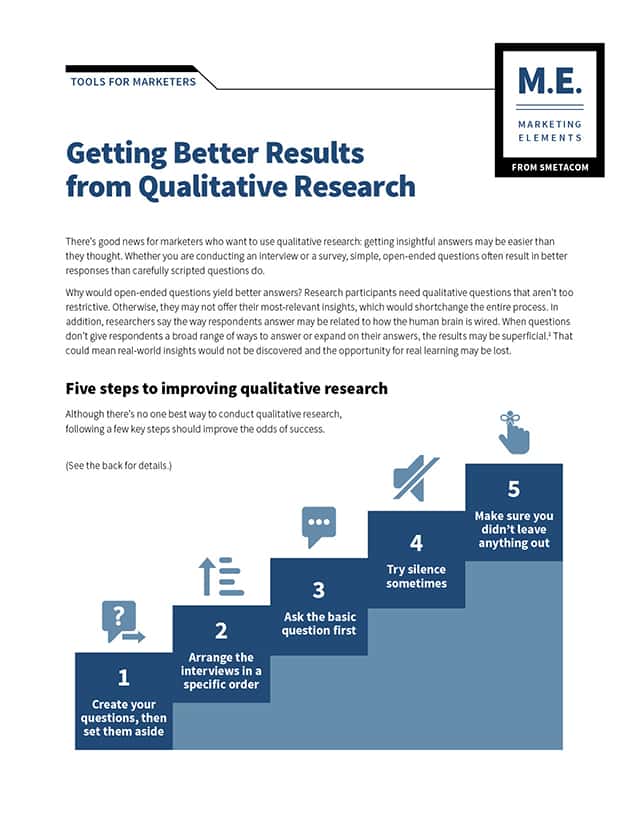Getting Better Results from Qualitative Research
There’s good news for marketers who want to use qualitative research: getting insightful answers may be easier than they thought. Whether you are conducting an interview or a survey, simple, open-ended questions often result in better responses than carefully scripted questions do.
Why would open-ended questions yield better answers? Research participants need qualitative questions that aren’t too restrictive. Otherwise, they may not offer their most-relevant insights, which would shortchange the entire process. In addition, researchers say the way respondents answer may be related to how the human brain is wired. When questions don’t give respondents a broad range of ways to answer or expand on their answers, the results may be superficial.1 That could mean real-world insights would not be discovered and the opportunity for real learning may be lost.
Five steps to improving qualitative research
Although there’s no one best way to conduct qualitative research, following a few key steps should improve the odds of success.
(See below for details.)

Five Steps to Improving Qualitative Research: The Details

1. Create your questions, then set them aside
Before conducting an interview, create a list of questions and study them. Then, at the start of the interview, set the questions aside and start a conversation about the topic. This should help interviewees relax and foster natural responses. If necessary, refer to your list of questions. Also, consider having one person ask questions and another person keep track to make sure all points are covered and documented.

2. Arrange the interviews in a specific order
Start by interviewing people inside the company, moving from those lower on the corporate hierarchy to upper levels of management. Better understanding the interests and expectations of direct stakeholders, or insiders, can help prepare you for interviews with external audiences. Based on the insights gained from talking with insiders, you can craft interview questions for external audiences such as customers, prospects, the media, influencers, etc.

3. Ask basic questions first
Try starting out a qualitative research interview with some more basic questions about the interviewees. Ask them about themselves, their background, the company, product category, competition, etc. Open-ended questions can work well for finding out this type of information. Then you can move on to more in-depth questions related to specific topics of interest for the research study.

4. Try silence sometimes
Avoid the temptation to hand interviewees answer options. When an interviewee is slow to respond, give them more time. They may be thinking or may be reluctant to answer. Since people tend not to like silence, oftentimes they will eventually respond.

5. Make sure you didn’t leave anything out
Ask a general “clean-up” question at interview’s end, such as “What else would you like to tell me that we didn’t discuss?” This is a common-sense tactic to make sure no stone was left unturned during the questioning.
Qualitative Research: The Brutal Facts
To get the most out of qualitative research, consider these tips:
- Try to get an “insider” (sales manager, customer service representative, etc.) to set up important interviews with customers and key prospects. Consider an honorarium as an inducement to yield more participation.
- Be realistic about the length of time interviews will take. Research suggests a 1-hour in-depth interview can provide reliable market research.2 Underestimating the amount of time needed could be a point of contention.
- Using a third party to conduct interviews can provide a desired level of detachment that may insulate you from sensitive questions. Plus, a third party can ask elementary questions without putting your expertise in question.
- To promote candid responses, guarantee the anonymity of responses. In your future conversations and reports, don’t link a response with a source. Be prepared for pressure from the sales staff and even upper management to break that guarantee.
- Recording interviews can intimidate some interviewees and cause them to be less forthcoming. Some will even stage their answers to make them politically correct. Having an associate present to document responses is a good alternative.
- Prioritize your questions by things that are mandatory, nice to know, and optional. Make sure to ask everything you must know. If time permits, ask all of your questions.
- Be willing to ask some questions not on the list. Then you can deviate from the list and follow the interviewee’s train of thought if there’s time.
SUMMARY
If you’re considering qualitative research as one of your marketing tactics, there are several methods that can be used to collect information. These fall into two general categories— interviews and surveys. Interviews are often conducted in-person, via telephone or in focus groups. Surveys are often done via Internet, mail or even telephone. The five steps discussed here to improve qualitative research are best suited for interviews, but may prove helpful for surveys as well.
1 Antman, M. Five Simple Techniques for Getting Better Results from Qualitative Research. Available at: www.mcsweeneyantman.com/index.asp?page=10&content=26. Accessed August 13, 2008.
2 Hauser, J. and Griffin, A.The voice of the customer. Marketing Science. Winter 1993;12(1).
